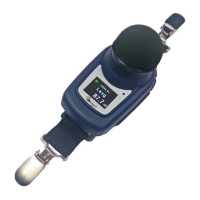May 2015 Page 40 of 51
LAS is the A-weighted sound level measured with Slow Time Weighting.
LASmax is the maximum A-weighted sound level measured with Slow Time
Weighting
LAvg is a parameter used in predominately in OSHA measurements. It is
the average sound level over the measurement period (equivalent to
Leq). Normally the term is used when the exchange rate “Q” is some
value other than 3, e.g. for the OSHA Hearing Conservation
Amendment where Q=5. A Threshold Value is also used during the
calculation of LAvg where any levels below the Threshold Value are
not included. For example, if the Threshold Value is set to 80dB and
the exchange rate is 5dB (Q = 5). If a one hour measurement was
taken in an environment where the noise levels vary between 50 and
70dB, the sound level would never exceed the Threshold Value so the
instrument would record no value for the LAvg. However, if the sound
level exceeds the 80dB Threshold Value for only a few seconds, only
these seconds will contribute to the LAvg, giving a level of around
40dB. This is much lower than the actual ambient sound levels in the
measured environment. For a constant level noise signal above the
threshold, the LAvg values based on exchange rates of 3 or 5dB will
be identical. In an environment of changing noise levels then the
energy will be accumulated according to 3 or 5dB exchange rates and
so Lavg (Q3) and Lavg(Q5) will then differ (with Lavg(Q5) being the
lower of the two results)
LCpk is the peak C-weighted sound level.
LEP,d is the daily personal noise exposure defined by ISO 1999. It is the
LAeq normalised to an 8 hour Criterion Time, i.e. a ‘standard day’. For
example, if a noise measurement was made for 4 hours and the LAeq
value was 90dB(A), the LEP,d value would be calculated to be
87dB(A) as the measurement duration is half the 8 hour Criterion Time
and the exchange rate is 3dB. Also LEX,8Hr. LEP,d is calculated from
the measured Sound Exposure, the Exposure Time and a Reference
Time of 8 h.
LCeq is the C-weighted equivalent level i.e. the C-weighted average level
over the measurement period. According to ISO procedures, doubling
the energy results in a 3dB change in the Leq or an ‘exchange rate’ of
Q=3. There is no Threshold Value taken into account.
Peak is the maximum level in dB reached by sound pressure at any instant
during the measurement period. With the dBadge2, Peak can be
measured with C, Z or A Weighting.
Slow Time Weighting is a standard time weighting applied by the sound level measurement
instrument.
SPL is the sound pressure level. This is the basic physical measure of
noise, and is normally expressed in dB.

